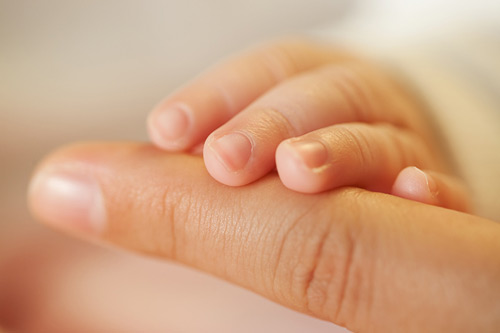Trimming Your Baby's Nails

Newborn nails are very soft. As they dry out (as your baby gets older), your baby can easily scratch herself. When your baby is a few days old, use an emery board to smooth out rough edges. After a few weeks, use a small nail clipper or scissors. If you notice scratches after a nap, check the nails. Your baby may be scratching her face while waking.
Hint: A great time to trin fingernails is when your baby is napping.
What You Need
Nail clippers or manicure scissors designed for infants are best. The tips are rounded for safety. Look for these products where you buy other baby supplies.
Resist the temptation to trim your baby's fingernails with your teeth. The nails may tear easily, but not evenly. And the germs in your mouth may cause an infection if there's a break in your baby's skin. You can get the job done in three easy steps.
Get a grip. Use one hand to hold your baby's finger or toe. To reduce the likelihood of a pinch or cut, press the skin under the nail down and out of the way. Trim the nail. Use the other hand to trim the nail and round off any sharp edges. For fingernails, follow the nail's natural shape. For toenails, trim straight across. Check your work. When you've trimmed all the nails, smooth any rough edges with a soft emery board.
At first, your baby's fingernails may grow more quickly - and need more attention - than his or her toenails. But even if your baby's toenails don't need to be trimmed, check them for sharp or rough edges that may get caught on blankets or clothing.
When Baby Won't Hold Still
A squirming baby can take the challenge of trimming tiny nails to a new level. It may help to trim your baby's nails after a bath, when the nails are softer. You might ask another person to hold or distract the baby while you trim his or her nails - or simply wait until your baby is asleep.
If You Cut Too Close
If you accidentally cut one of your baby's nails too short or nick a finger or toe, apply gentle pressure with a clean tissue or sterile gauze pad. Once the bleeding stops, there's no need to cover the area with a bandage. It may only pose a choking hazard.
 PREGNANCY
PREGNANCY  GIVING BIRTH
GIVING BIRTH  BABY CARE
BABY CARE  HEALTH & SAFETY
HEALTH & SAFETY  FUN STUFF
FUN STUFF  FAMILY
FAMILY 